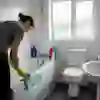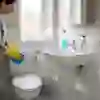Share:
Keeping a bathroom clean is more than just a matter of aesthetics; it’s essential for health and comfort. As high-use, high-moisture spaces, bathrooms are prime environments for the growth of mould, mildew, and bacteria. So, maintaining a high standard of hygiene directly impacts the well-being of everyone in your home.
Here, The Bathroom Showroom offers a deep clean bathroom guide providing practical, step-by-step guidance on proven cleaning techniques, highlighting the best tools and products for every task, and offering scheduling tips to make maintaining a truly clean and comfortable bathroom easier and more effective.

Common Bathroom Cleaning Challenges
1. Hard Water Stains and Soap Scum
- Hard Water Stains (Limescale/Mineral Deposits): These are chalky white, gray, or sometimes reddish-brown spots/films left behind when water, which contains high concentrations of dissolved minerals (primarily calcium and magnesium), evaporates. These mineral deposits build up on surfaces like glass, taps, and tiles.
- Soap Scum: This is a sticky, greasy, off-white film that forms when the minerals in hard water react with the fatty acids in soap. It creates a film on shower walls, bathtubs, and sinks, and it provides a food source for mould and mildew.
2. Mould and Mildew Build-up
- Cause: Mould and mildew thrive in the warm, moist, and humid environment of a bathroom, especially when the humidity level exceeds 60%.
- Contributing Factors (Damp Climates and Poor Ventilation): In damp climates or poorly ventilated bathrooms, the moisture-laden air (created by showers/baths) cannot escape effectively. This causes water vapour to condense on cool surfaces like walls, ceilings, and windows, creating the damp conditions necessary for mould spores to germinate, grow, and reproduce.
3. Delicate Surfaces (Natural Stone, Laminate, and Glass)
- Risk: These materials can be easily damaged, scratched, or discoloured by using the wrong cleaning products or tools.
- Natural Stone (e.g., Marble, Limestone): This is the most sensitive. It is composed of calcium carbonate and is highly vulnerable to damage, known as etching (a dull mark), from acidic cleaners like vinegar, lemon juice, or harsh bathroom cleaners. Abrasive tools can also cause scratches.
- Glass and Laminate: While generally tougher than natural stone, they can be scratched by abrasive pads or powders, and residues from non-specific cleaners can leave behind streaks or a cloudy film.
4. High Traffic vs. Low Traffic Bathrooms
- Challenge: The frequency of use directly impacts the cleaning schedule required to maintain hygiene and prevent build-up.
- High Traffic Bathrooms: These include family or shared spaces where surfaces are touched more often, and water is used frequently. They accumulate dirt, germs, soap scum, and moisture faster, requiring more frequent and consistent cleaning (often daily spot cleaning and at least weekly deep cleaning) to maintain a healthy environment.
- Low Traffic Bathrooms: These are used less often (e.g., a guest bathroom). While still requiring regular cleaning to prevent dust and mineral build-up, the thorough cleaning schedule can often be less frequent (e.g. bi-weekly or monthly), provided basic maintenance is kept up.

How Often Should You Clean Your Bathroom?
1. Toilets
- Recommended Products/Tools: Toilet cleaner, toilet brush, descaler (for hard water stains/limescale).
- Frequency Guidance: Weekly.
- Key Techniques/Notes: Apply cleaner inside the bowl and under the rim. Scrub gently but thoroughly with a brush.
Under Rim
- Recommended Products/Tools: Toilet cleaner, descaler (for hard water), white vinegar (soaked on paper towels and left overnight), or a thin scrubbing tool.
- Frequency Guidance: Weekly (Focus on build-up removal).
- Key Techniques/Notes: Apply an acidic cleaner (like vinegar or descaler) to break down mineral/limescale build-up that a brush might miss. Use a small cloth/paper towel and a gloved hand for thorough wiping under the rim to maintain cleanliness.
Seat, Lid, Exterior, Handle
- Recommended Products/Tools: All-purpose cleaner, disinfectant spray/wipes.
- Frequency Guidance: Daily Spot-Clean (Exterior spills/splatter) & Weekly Disinfect.
- Key Techniques/Notes: Wipe down all exterior surfaces, seat, and lid with disinfectant, moving from least dirty to most dirty areas. The handle should be disinfected at least weekly.
Cistern/Tank (Internal)
- Recommended Products/Tools: Mild acid (like white vinegar) or a specialised descaler.
- Frequency Guidance: As needed (If flushing power is reduced or there's mineral build-up.)
- Key Techniques/Notes: Turn off the water supply, flush to empty the tank, pour in cleaner/acid, and let it sit before scrubbing and flushing. Use caution with strong acids and ensure good ventilation.
Daily Wipe vs. Weekly Deep Clean:
- Daily: Focus on a quick spot-clean of the exterior (seat and outer bowl) with an all-purpose cleaner to manage spills and high-touch points.
- Weekly: A thorough clean of the bowl interior, including under the rim, using a toilet cleaner and brush, followed by disinfecting the seat and exterior.
2. Basins & Countertops
General Cleaning (Water marks, toothpaste, light soap scum)
- Recommended Products/Tools: Mild dish soap & hot water, general bathroom surface cleaner, mild vinegar solution (equal parts vinegar & water).
- Frequency Guidance: Daily Spot-Clean (Wipe down after use) & Weekly Deep Clean.
- Key Techniques/Notes: Wipe surfaces with a soft cloth or sponge. Rinse well to prevent residue. Dry surfaces after use to prevent water marks.
Ceramic/Porcelain
- Recommended Products/Tools: Mild liquid soap, vinegar-based cleaner, proprietary limescale remover.
- Frequency Guidance: Weekly.
- Key Techniques/Notes: AVOID abrasive cleaners or tools like scouring pads, stiff-bristled brushes, or abrasive powders to prevent scratching the surface.
Natural Stone (Marble, Granite, etc.)
- Recommended Products/Tools: Mild dish soap & water or a commercially made stone cleaner.
- Frequency Guidance: Weekly.
- Key Techniques/Notes: AVOID acidic cleaners like vinegar, lemon juice, or harsh chemical cleaners, as the acidity can etch and damage soft/porous stone.
Laminate/Other
- Recommended Products/Tools: General bathroom cleaner, or mild soap and water.
- Frequency Guidance: Weekly.
- Key Techniques/Notes: Generally durable, but always check manufacturer instructions for specific product recommendations.
Tough Build-Up (Soap scum, hard water)
- Recommended Products/Tools: Vinegar solution (let sit for 10-30 mins), or baking soda paste followed by vinegar.
- Frequency Guidance: As needed.
- Key Techniques/Notes: For stubborn residue, use a soft toothbrush around faucets/edges. Always check if vinegar is safe for your countertop material (e.g. AVOID on stone).
3. Cleaning Showers & Baths
Limescale & Soap Scum
- Recommended Products/Tools: White vinegar & baking soda paste, lemon juice, commercial soap scum/limescale remover, hydrogen peroxide & baking soda paste.
- Frequency Guidance: Weekly (Full clean).
- Key Techniques/Notes: Apply an acid-based cleaner (vinegar, lemon juice) or commercial remover, allow it to dwell (15+ mins), scrub with a sponge/soft brush, and rinse thoroughly. Do not use acid on stone surfaces.
Mould & Mildew
- Recommended Products/Tools: Bleach-based cleaner (check compatibility with surfaces), hydrogen peroxide, steam cleaner.
- Frequency Guidance: As needed (Spot treat).
- Key Techniques/Notes: Ensure proper ventilation when using strong chemicals. Use a stiff brush on mouldy areas. Prevention: Dry surfaces and ensure good ventilation.
Glass Doors
- Recommended Products/Tools: Dish soap & warm water, vinegar/water solution, specialised glass cleaner.
- Frequency Guidance: Daily (Squeegee) & Weekly (Clean).
- Key Techniques/Notes: Use a squeegee immediately after every shower to prevent water spots and soap scum from forming. For a clean, apply solution and scrub, then squeegee and wipe dry with a microfibre cloth.
Squeegee Use
- Recommended Products/Tools: Shower squeegee with a rubber lip.
- Frequency Guidance: After Every Use.
- Key Techniques/Notes: Squeegeeing is a highly effective preventative measure. It removes water residue, soap, and grime, significantly reducing the need for heavy scrubbing during weekly cleans.
Tile/Grout
- Frequency Guidance: Weekly.
- Key Techniques/Notes: Use non-abrasive cleaners on tiles. Cleaners for limescale/scum will help with tile surfaces. (See Tiles & Grout section below).
4. Cleaning Bathroom Tiles & Grout
General Stains/Dirt
- Recommended Products/Tools: Hot water & dish soap, all-purpose cleaner.
- Frequency Guidance: Weekly (As part of floor/shower clean).
- Key Techniques/Notes: Scrub grout lines with a toothbrush or soft-bristled brush.
Whitening & Tough Stains
- Recommended Products/Tools: Baking soda paste (left overnight), hydrogen peroxide spray/paste, oxygen-based bleach powder, and steam cleaner.
- Frequency Guidance: As needed (Monthly or when stains appear).
- Key Techniques/Notes: Avoid vinegar on porous stone tiles. Test the bleach in an inconspicuous area, as it can damage some tiles. Grout Pens can cover up stains but are a cosmetic fix, not a clean.
Preventative Measures
- Recommended Products/Tools: Routine wipe-downs, good ventilation, grout sealer.
- Frequency Guidance: Daily/Weekly (Wipe-downs), Yearly (Sealing).
- Key Techniques/Notes: Use the exhaust fan during and after showering to minimise moisture. Wiping up spills prevents staining.
- Recommended Products/Tools: Grout sealer (paint, roll, or spray applicator).
- Frequency Guidance: Periodically (Check manufacturer guidelines, often yearly).
- Key Techniques/Notes: Sealing grout closes the pores, preventing dirt, stains, and moisture from penetrating, making cleaning much easier. Ensure grout is thoroughly clean and dry before applying the sealer.
5. Mirrors & Fixtures
- Recommended Products/Tools: Commercial glass cleaner (foaming is good), homemade solutions (water/vinegar/alcohol mix), plain water.
- Frequency Guidance: Daily Spot-Clean (Toothpaste/splatter) & Weekly Deep Clean.
- Key Techniques/Notes: Use a lint-free cloth (microfibre or flat-weave cotton), coffee filter, or crumpled newspaper for the final polish. Avoid cleaning in direct, bright sunlight, as the heat can cause cleaners to dry too quickly and streak. Wipe top to bottom, then side to side, for best results.
Chrome Fixtures/Taps
- Recommended Products/Tools: Mild dish soap & water, vinegar solution (soaked on a cloth).
- Frequency Guidance: Weekly.
- Key Techniques/Notes: Polish/Dry immediately after cleaning to prevent water spots and streaks. For hard water build-up, soak a cloth in vinegar and wrap it around the fixture for about an hour before scrubbing with a soft toothbrush.
Tough Spots (Chrome)
- Recommended Products/Tools: Isopropyl alcohol.
- Frequency Guidance: As needed.
- Key Techniques/Notes: Use a soft cloth to gently polish away stubborn residue. Always wipe down and dry the surface immediately after cleaning.

Recommended Bathroom Cleaning Products and Tools
Eco-Friendly vs. Traditional Chemical Cleaners
You have two main paths for bathroom cleaning products: eco-friendly or traditional chemicals.
Eco-friendly options typically use plant-derived, non-toxic, and biodegradable ingredients, often coming in refillable or plastic-free packaging to reduce environmental impact. They’re a gentler choice for your home and the planet. Examples include concentrated refills and plant-based eco-friendly bathroom sprays like those from Kinfill, Homethings, or Ecover.
Traditional chemical cleaners often contain powerful, fast-acting ingredients like chlorine bleach or ammonia for heavy-duty disinfecting and stain removal, but they can pose risks to respiratory health and aquatic life.
------------------------------------------------------------
Essential Cleaning Tools
A few simple tools are all you need for an effective clean. Sponges and microfiber cloths are versatile for wiping surfaces, soaking up spills, and polishing. Brushes are necessary for scrubbing grout and getting into tight corners, with a dedicated toilet brush being essential.
A squeegee is a highly recommended tool for daily use on glass shower doors and mirrors to prevent water spots and soap scum build-up, significantly reducing the need for heavy-duty cleaning products.
------------------------------------------------------------
Optional: Steam Cleaning for Deep Hygiene
For a deep, chemical-free clean, a steam cleaner is a powerful option. It uses high-temperature steam to sanitise surfaces, dissolve soap scum, kill mould spores, and blast dirt from grout lines. This is particularly effective for deep hygiene in areas like shower recesses, tile floors, and porcelain fixtures without relying on chemical disinfectants.
------------------------------------------------------------
DIY Cleaning Sprays and Materials
You can easily create effective cleaning agents using common household ingredients. A simple and powerful combination for a general bathroom spray is a mix of white vinegar and water (often 50/50), which is great for removing hard water spots and disinfecting. Baking soda mixed with a small amount of dish soap or water forms a paste that is an excellent gentle scouring agent for tubs and sinks.

Simple Bathroom Cleaning Tips That Help Create an Inviting Space
By following a consistent schedule and proven techniques outlined in this guide, you can successfully tackle common bathroom challenges, from hard water spots to mould and mildew.
Consistent and correct cleaning is the best form of protection. A proactive routine not only ensures a high standard of hygiene for your home but also actively prevents mould growth and safeguards expensive surfaces (like natural stone and chrome) from damage and irreversible build-up, ensuring your beautiful bathroom remains comfortable and pristine for years to come.
For further help with choosing the best products to keep your bathroom looking fabulous all year round, book an appointment with The Bathroom Showroom. Experts in all things bathrooms, we can help turn your dream bathroom into a reality.